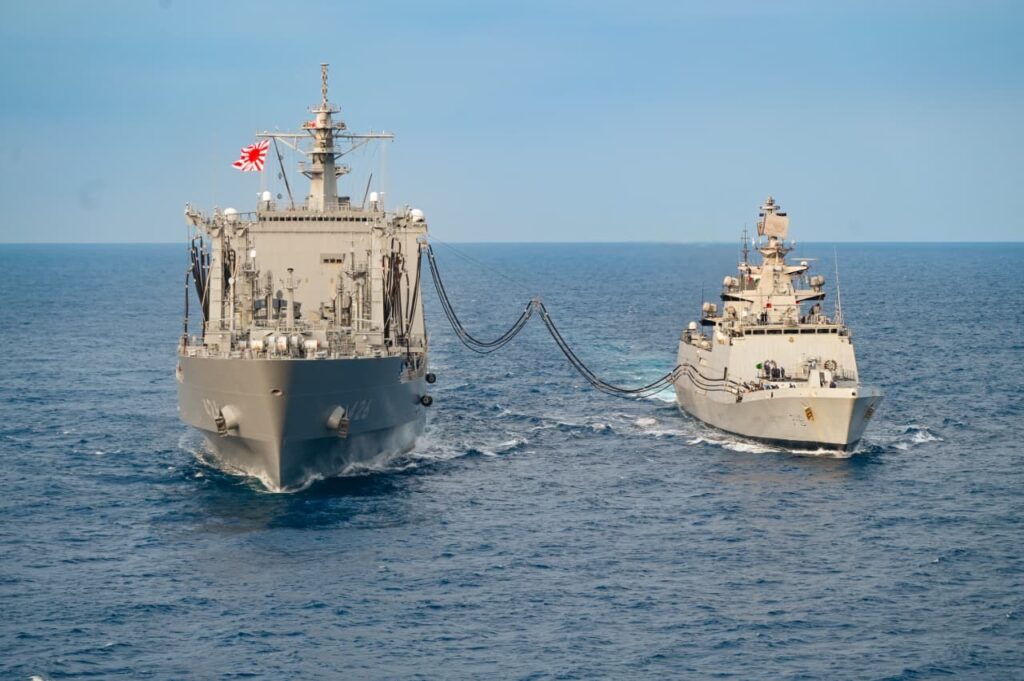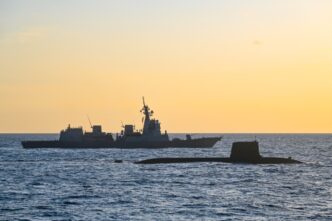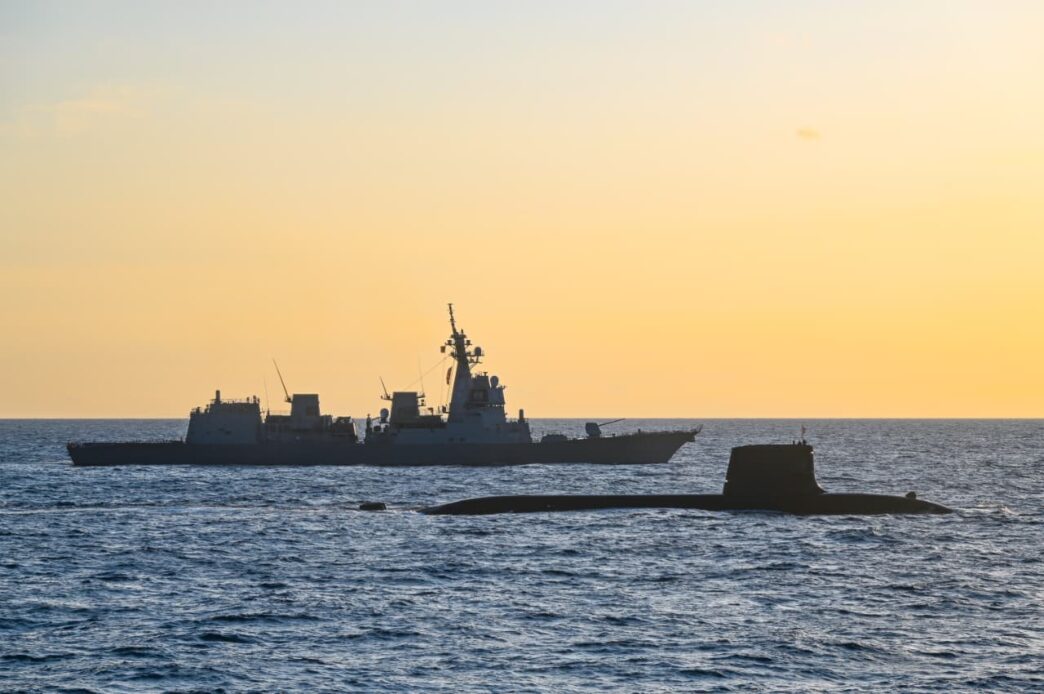
Introduction
In mid-October 2025, the navies of Indian Navy and Japan Maritime Self‑Defense Force (JMSDF) came together for the bilateral maritime exercise designated JAIMEX 25 (Japan-India Maritime Exercise 2025). The exercise took place off the western coast of Japan’s Kyushu island from 16 to 17 October, followed by a harbour phase at the Japanese port of Yokosuka on 21 October.
Participants & Major Assets
- From India: The indigenously built stealth frigate INS Sahyadri (Shivalik-class) commanded by Capt. Rajat Kumar.
- From Japan: The destroyer JS Asahi, fleet oiler JS Oumi and a submarine (reported to be Jinryu) participated in the sea phase.
- Supporting elements: The Japanese Ground Self-Defense Force’s 2nd Artillery Brigade and the Japanese Air Self-Defense Force’s Western Aircraft Control & Warning Wing provided support.
Key Objectives and Activities
The exercise emphasised several core objectives:
- Enhancing tactical capabilities of the JMSDF and the Indian Navy.
- Strengthening interoperability between the navies of India and Japan across surface, sub‐surface and air domains.
- Demonstrating and promoting a shared vision of a free, open and inclusive Indo-Pacific maritime region.
In terms of activities:
- Sea Phase (16-17 October): The ships carried out advanced drills including anti-submarine warfare (ASW), missile defence exercises, flying operations and underway replenishment (refuelling & logistics at sea).
- Harbour Phase (21 October at Yokosuka): The participating crews engaged in professional and cultural exchanges — cross-deck visits, collaborative operational planning, sharing best practices, and a joint yoga session to foster camaraderie.
Strategic Significance
This exercise carries several layers of significance:
- Bilateral Defence Deepening
India and Japan’s defence and security cooperation has been steadily growing. JAIMEX 25 serves as a tangible manifestation of the two countries’ “Special Strategic and Global Partnership” under which naval cooperation forms a key pillar. - Maritime Domain Awareness & Indo-Pacific Stability
With the two navies honing their abilities to operate jointly in complex maritime environments, they signal a stronger commitment to peace and stability in the Indo-Pacific region. The exercise underlines that maritime order, freedom of navigation, and interoperability among like-minded navies are central to their shared agenda. - Operational Capability & Logistics
The inclusion of underway replenishment, air operations, ASW drills and multi-domain coordination (sea, air, land support) indicates a shift beyond basic naval drills towards more complex, high-end operations. For example, JMSDF emphasised improving tactical capabilities and integrating with Indian Navy and other services. - Symbolic and Diplomatic Dimensions
The port call of INS Sahyadri at Yokosuka (a major Japanese naval base) and the formal reception of the ship reflect both nations’ diplomatic signalling. The joint naval diplomacy underscores the broader strategic alignment of India and Japan as maritime democracies.
Context & Broader Trends
- Though labelled “JAIMEX 25”, earlier maritime exercises between the two navies have used the name “JIMEX”. The change in nomenclature could signal a recalibrated or more prominent format. For instance, previous exercises — e.g., “JIMEX 24” in June 2024 — took place between India and Japan.
- The exercise reflects India’s continuing “Long Range Deployment” of ships into the Indo-Pacific and Japan’s increased outward maritime engagement. The harbour phase of JAIMEX followed INS Sahyadri’s deployment.
- The exercise comes amid a backdrop of evolving security dynamics in the Indo-Pacific: rising maritime competition, challenges of under-sea warfare, growing significance of logistics & sustainment, and the role of middle powers in shaping a “rules-based order”.
Implications for India and Japan
- For India: The participation of INS Sahyadri (indigenous Shivalik-class) underscores India’s push for enhanced naval diplomacy and credible indigenous maritime capability (aligned with the “Atmanirbhar Bharat” vision).
- For Japan: The strengthening of Japan’s cooperation with India, backed by JMSDF’s joint drills east of Kyushu, signals Tokyo’s willingness to deepen partnerships beyond traditional allies. The involvement of JGSDF and JASDF support units also reflects Japan’s integrated defence posture.
- Jointly: The two countries enhance their messaging to regional stakeholders: that they are prepared to work together in multi-domain maritime operations, which may act as a deterrent or stabilising factor in the wider region.
Key Takeaways
- JAIMEX 25 was a high-end, multi-domain bilateral maritime exercise, not simply a harbour visit or passage exercise.
- The exercise signals maturation of India-Japan naval cooperation: beyond simple drills to full-scale interoperability involving under-sea, air and logistics domains.
- Strategic messaging: it reinforces the maritime dimension of the India-Japan partnership and their mutual interest in the Indo-Pacific’s maritime order.
- The exercise also provides both navies with an opportunity for learning, capability enhancement and operational readiness in contingent/coalition scenarios.
- For observers, JAIMEX 25 may be seen as part of an ongoing process where middle-power navies (India, Japan) assume greater roles in maintaining maritime stability and networked cooperation.
Conclusion
JAIMEX 25 stands out as a significant milestone in India-Japan defence cooperation. By marrying advanced operational drills with strategic diplomacy, the exercise underscores both nations’ commitment to enhancing maritime security, interoperability and regional stability. As the Indo-Pacific’s maritime environment grows more complex, such exercises will likely become more frequent and sophisticated — serving not only tactical goals but also broader strategic partnership objectives.
Originally by : https://www.facebook.com/IndiaInJapan/
Original article link: https://indiashippingnews.com/japan-india-maritime-exercise-jaimex-2025/
Also Read: Japan Real Estate Investing in 2025: Understanding REITs and Crowdfunding

















